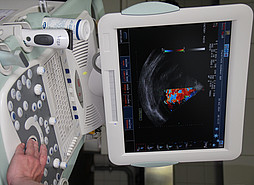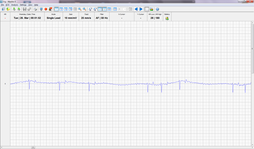Cardiac Disorders and Echocardiography
Disorders of the cardiovascular system regularly occur in sport and leisure horses and can have different effects. Heart murmurs or arrhythmias are often detected incidentally during routine examinations such as vaccinations or a pre-purchase examination. Beyond that, however, cardiac disorders may also become clinically relevant. Symptoms range from poor performance and reduced exercise tolerance to oedema (accumulation of fluid in the pectoral region) and dyspnoea.
Among others, the most common cardiac disorders are mitral valve insufficiency, aortal valve insufficiency and atrial fibrillation.
In case of a suspected cardiac disorder, further examinations should definitely be initialised. This is the only possibility to reach an accurate diagnosis and to be able to provide a prognosis regarding athletic use of the horse and also safety of horse and rider.
Echocardiography and ECG (electrocardiography) are at the centre of further cardiological examinations.
Echocardiography
Using state-of-the-art ultrasound units, sonographic images of the heart can be obtained. For morphological examination of the heart (changes in dimension, valve thickening, myocardial changes etc.), the so-called B-mode and M-mode are used. In addition, regurgitations can be visualised and their velocity measured by using the colour Doppler and the spectral Doppler (PW Doppler, CW Doppler).
Electrocardiography
Using ECG, the electrical activity of the cardiac muscle can be visualised and thus provide information on the function of the conduction system of the heart.
Recording an ECG is not only significant in cases of obvious arrhythmia but also of particular importance in cases of marked valvular insufficiency.
Certain arrhythmias can lead to sudden collapse of the horse and thus pose a danger to horse and rider.
With the aid of a so-called Holter monitor, we can obtain an ECG at rest, a 24-hour ECG and a performance ECG (on the lunge or the treadmill).
![[Translate to English:] Kleintiermedizin Hochmoor [Translate to English:] Kleintiermedizin Hochmoor](/kv/_processed_/7/e/csm_Kleintiermedizin-Hochmoor_c796a9e531.jpg)
![[Translate to English:] Klinik für Pferde [Translate to English:] Klinik für Pferde](/kv/_processed_/0/d/csm_pferdeklinik-01_c18cc541af.jpg)
![[Translate to English:] Allgemeine Untersuchung Kleintier [Translate to English:] Allgemeine Untersuchung Kleintier](/kv/_processed_/1/5/csm_allgemeine-Untersuchung-Kleintier_cdba7ebb98.jpg)
![[Translate to English:] Lahmheitsuntersuchung Pferdeklinik Hochmoor [Translate to English:] Lahmheitsuntersuchung Pferdeklinik Hochmoor](/kv/_processed_/2/e/csm_Lahmheitsuntersuchung-Pferdeklinik-Hochmoor_8e9ec18025.jpg)

![[Translate to English:] Tiermedizin Hochmoor CT Hund [Translate to English:] Tiermedizin Hochmoor CT Hund](/kv/_processed_/6/4/csm_Kleintiermedizin-3_56aa5d056b.jpg)
![[Translate to English:] Tiermedizin Hochmoor Kleintiermedizin [Translate to English:] Tiermedizin Hochmoor Kleintiermedizin](/kv/_processed_/d/e/csm_Tiermedizin-Hochmoor-Kleintiere_5f8df77a2f.jpg)
![[Translate to English:] Pferdemedizin Hochmoor [Translate to English:] Pferdemedizin Hochmoor](/kv/_processed_/5/6/csm_Pferdemedizin-Hochmoor_2a06563c44.jpg)


![[Translate to English:] EKG beim Pferd ECG in the horse](/kv/_processed_/e/7/csm_re_Holter-EKG_5584a427d9.jpg)
![[Translate to English:] Aortenklappeninsuffizienz Farbdoppler Aortic valve insufficiency colour Doppler](/kv/_processed_/7/6/csm_Aortenklappeninsuffizienz_Farbdoppler_42efcdaf9d.jpg)
![[Translate to English:] Aortenklappeninsuffizienz Spektraldoppler Aortic valve insufficiency spectral Doppler](/kv/_processed_/9/6/csm_Aortenklappeninsuffizienz_Spektraldoppler__CW-Doppler__d2a1bf1409.jpg)